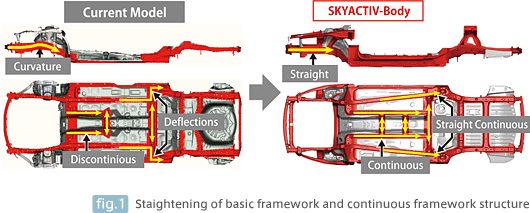Talk about the body, excellent rigidity supporting Mazda's fun-to-drive feel, with a lightweight body to achieve outstanding crash safety performance. SKYACTIV body feature :
- High rigidity and lightness (8% lighter, 30% more rigid)
- Crash safety performance that meets the top criteria for crash safety assesment in all market.
Ideal body structure
In terms of structure, Mazda revise the basic principe. For the basic framework, they adopted the concepts of 'straightening' and a 'continuos framework' in which each section functions in a coordinate manner with the other section of the framework. Mazda ensure that the structure disperses force widely throughout the entire framework, rather than receiving the force on only specific sections of the vehicle. That was all important thing that need to be consider when Mazda creating a light body yet strong framework.
Straight and continous basic framework
For the underbody area, curves were removed as much as possible to create a straight frame in a continuous configuration from the front to the rear. For sections of the frame that still require some curvature, Mazda implemented continuous bonding with the horizontal frame to make the structure a closed section, thus contributing significantly to weight reduction while at the same time achieving rigidity.
The upperbody also functions as a constituent part of the continuously bonded framework. Specifically, the suspension mounting positions at the front and rear of the upperbody are directly bonded with the underbody framework as a “dual brace”. In addition, by creating four ring structures for the upperbody that includes the roof rail and B-pillar, and the entire reinforcement area of the underbody, the overall rigidity of the body has been further enhanced.
The upperbody also functions as a constituent part of the continuously bonded framework. Specifically, the suspension mounting positions at the front and rear of the upperbody are directly bonded with the underbody framework as a “dual brace”. In addition, by creating four ring structures for the upperbody that includes the roof rail and B-pillar, and the entire reinforcement area of the underbody, the overall rigidity of the body has been further enhanced.
Multi-load path structure
To improve crash safety performance, Mazda adopted a multi-load path structure. The structure efficiently absorbs the load at the time of a crash by dispersing it in multiple directions. For example, energy received when a frontal collision occurs is absorbed by being dispersed along three continuous routes (paths): from the front frame to the B-frame, from the front frame to the side of the body, and from the front frame to the A-pillar. In particular, the upper branch frame, which diverts the load to the A-pillar, is a multi-functional part that also works to cancel the upward motion of the front frame. To create this kind of path, parts such as door hinges, which do not normally play a role in absorbing shock, are important elements in the design. Naturally, the multi-load path structure is adopted for lateral collisions and rear collisions as well to function in the same way, thus greatly improving safety performance.
The multi-load path approach was also adopted for individual parts. Mazda focused on directing the crash energy mainly along the ridge lines of the parts, molding the front tip of the front frame into a cross shape. In a conventional square section, there are four ridge lines, but when a cross is created there are twelve ridge lines, and the shock is dispersed more widely. By doing so, the energy is then absorbed more efficiently, the space in the engine room is more effectively used, and there is also greater freedom in exterior design.
Engineering process
To create a circular structure for the reinforcement, weld bonding was used for the roof rail section. Before SKYACTIV this structure was separated from the rear frame due to the body assembly process. To bond this section directly, Mazda has adopted a method whereby the parts are bonded together in advance using the weld bonding method and then sent on to the assembly process as a bonded unit. By adopting this method, Mazda have achieved continuous bonding, at the same time greatly increasing the number of spot weld points, which contribute to the excellent body rigidity.
In terms of materials, Mazda have greatly increased their use of high-tensile steel, which is lightweight and has excellent strength and rigidity. In the new body , high-tensile steel, the thinnest in its class which is CD-segment car (Mazda6 class), is used for most of the main parts, and this has resulted in significant weight reduction benefits.







No comments:
Post a Comment